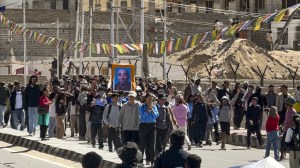Pawan Hans agitation grounded
January 5: The 39-day-old strike by pilots of Pawan Hans Helicopters Ltd was called off today afternoon following a memorandum of understand...

January 5: The 39-day-old strike by pilots of Pawan Hans Helicopters Ltd was called off today afternoon following a memorandum of understanding signed by Pawan Hans Pilots Guild and the management.
The signing of the agreement was mediated by officials from the office of Regional Labour Commissioner (Central). Following the signing of the agreement, the first regular flight to ONGC’s oil production platforms off Bombay High took off with Pawan Hans’ chairman and managing director H S Hundal on board at 4.15 pm. “Everything is going off smoothly and we will achieve normalcy by and by,” Preetam Dev, general manager (western region) said.
Most of the pilots’ demands have been accepted by the management. Pawan Hans has renewed services of contract pilots who were sacked when the strike began. As part of the agreement, Pawan Hans pilots will not be put on medical evacuation duty at night after they have completed a whole day’s flying. Instead, a fresh crew will be positioned at Bombay High to operate such flights. The issue of operating medical evacuation flights was the bone of contention between the Pilots Guild and the management, and it eventually led to the strike.
While the management insisted that the time spent by the crew positioned for operating medical evacuation flights overnight was a period of rest, the pilots felt otherwise. Even as arbitration was on, pilots refused to operate night flights, which led to a fracas between pilots and general employees of the airline on November 26-27 last year. This resulted in the pilots going on an indefinite strike citing danger to their lives. The withdrawal of the strike follows protracted negotiations between ONGC, which is a part-owner of Pawan Hans, the labour commissioner, the company and its unions. “Senior officials of ONGC like its director (technical), V Ghaur, were involved in helping us resolve the issue,” Ivor Simoes, president of the Pilots Guild said.
The strike caused enormous losses to the Oil and Natural Gas Commission. According to a company spokesman, oil output has fallen by two lakh barrels since the strike began. Oil output, which has dropped by 7000 barrels a day, will remain so at least for the next fortnight, the spokesman said. Every barrel of oil brings in a revenue of US $18 to ONGC. In addition to the loss in production, the commission has suffered disruption in its production and maintenance schedules.
ONGC requires the transportation of 150-180 persons between its off-shore rigs and the mainland every day. It also needs four to five helicopters exclusively for work to be carried out from one platform to another. Three choppers are parked every night on board the North, South and Hira field rigs. During the strike, ONGC managed with skeleton services by Pawan Hans executive pilots and flights by Mesco Airlines and other private operators. Moreover, boats were used to transport personnel from Mumbai docks to its off-shore installations.
Pawan Hans is reported to have lost between Rs 18 and Rs 20 lakh per day in revenues during the period of the strike. Sources, however, point out that much of it could be recouped by operating additional maintenance flights to various unmanned wells over the next few days. ONGC is Pawan Hans’ major customer. Out of its fleet of 22 helicopters, ten are in contract with ONGC.





- 01
- 02
- 03
- 04
- 05


























